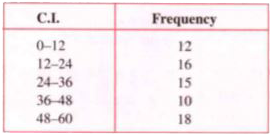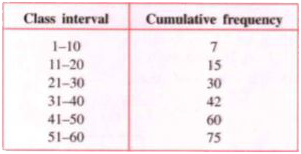For a frequency distribution 7th decile is computed by the formula
D7=l+(n7−c))f×i
D7=l+(n10−c))f×i
D7=l+(7n10−c))f×i
D7=l+(10n7−c))f×i
The correct Answer is:C
To compute the 7th decile (D7) for a frequency distribution, we can use the following formula:
Dn=L+(n10×N−C)×if
Where:
- Dn = nth decile
- L = lower boundary of the class containing the nth decile
- N = total number of observations
- n = the decile to be calculated (in this case, 7)
- C = cumulative frequency of the class preceding the class containing the nth decile
- i = class width (size of the class interval)
- f = frequency of the class containing the nth decile
1. Identify the values needed for the formula:
- Determine L, N, C, i, and f from the frequency distribution table.
2. Substitute the values into the formula:
- Since we are calculating the 7th decile, substitute n=7 into the formula:
D7=L+(710×N−C)×if
3. Calculate 710×N:
- Multiply the total number of observations N by 710.
4. Subtract the cumulative frequency C:
- Take the result from step 3 and subtract C (the cumulative frequency of the class before the class containing the 7th decile).
5. Calculate if:
- Divide the class width i by the frequency f of the class containing the 7th decile.
6. Combine the results:
- Add the lower boundary L to the product from step 4 and step 5 to find D7.
Final Result:
- The final result will give you the value of the 7th decile D7.
- Dn = nth decile
- L = lower boundary of the class containing the nth decile
- N = total number of observations
- n = the decile to be calculated (in this case, 7)
- C = cumulative frequency of the class preceding the class containing the nth decile
- i = class width (size of the class interval)
- f = frequency of the class containing the nth decile
- Determine L, N, C, i, and f from the frequency distribution table.
- Since we are calculating the 7th decile, substitute n=7 into the formula:
D7=L+(710×N−C)×if
- Multiply the total number of observations N by 710.
- Take the result from step 3 and subtract C (the cumulative frequency of the class before the class containing the 7th decile).
- Divide the class width i by the frequency f of the class containing the 7th decile.
- Add the lower boundary L to the product from step 4 and step 5 to find D7.
- The final result will give you the value of the 7th decile D7.
Similar Questions
For a frequency distribution standard deviation is computed by applying the formula (a)σ= ⎷∑fd2∑f−(∑fd∑f)2 (b)σ= ⎷(∑fd2∑f)−∑fd2∑f (c)σ=√∑fd2∑f−∑fd∑f (d) ⎷(∑fd∑f)2−∑fd2∑f
View SolutionFor a frequency distribution mean deviation from mean in computed by (a) M.D.=∑f∑f|d| (b) M.D.=∑d∑f (c) M.D.=∑fd∑f (d) M.D.=∑f|d|∑f
View SolutionFor a frequency distribution mean deviation from mean in computed by: (a) M.D.=∑f∑f|d| (b) M.D.=∑d∑f (c) M.D.=∑fd∑f (d) M.D.=∑f|d|∑f
View SolutionCumulative Frequency Distribution
View SolutionFrom the frequency distribution table from the following data

View SolutionGiven below is a cumulative frequency distribution showing the mars secured by 50 students of a class

From the frequency distribution table for the data.
View SolutionContruct a cumulative frequency distributions table from the following frequency table:

View SolutionContruct a cumulative frequency distributions table from the following frequency table:

View SolutionConstruct a cumulative, frequency distribution table from the frequency table given below :
Calss IntervalFrequency0−898−161316−241224−32732−4015
View SolutionThe mean of the following frequency distribution is 62.8 and the sum of all the frequencies is 50. Compute the missing frequency f1 and f2 . Class: 0-20 20-40 40-60 60-80 80-100 100-120 Frequency: 5 f1 10 f2 7 8
View Solution
